Bromeliads aren’t difficult to care for, but it’s quite different from other types of plants. Once you understand what they need, you’ll easily be able to keep yours thriving.
In this post I’ll show you everything you need to know to be successful. From watering and humidity, to soil, light, flowering, pruning, fertilizing, pest control, and much more, you’ll find it all right here.
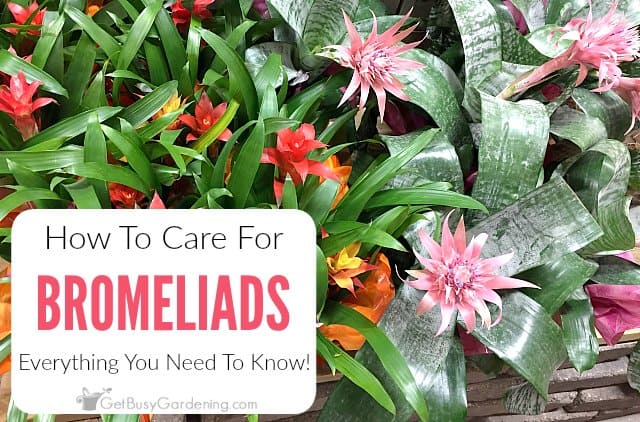
Information About Bromeliads
Like orchids and staghorn ferns, most types of bromeliads are epiphytes. That means they grow on trees, rocks or other plants in nature, and they get most of their water and nutrients from the air rather than the soil.
Some can be difficult to grow as houseplants, because they like humidity and can dry out too quickly in the average home (especially during the dry winter months).
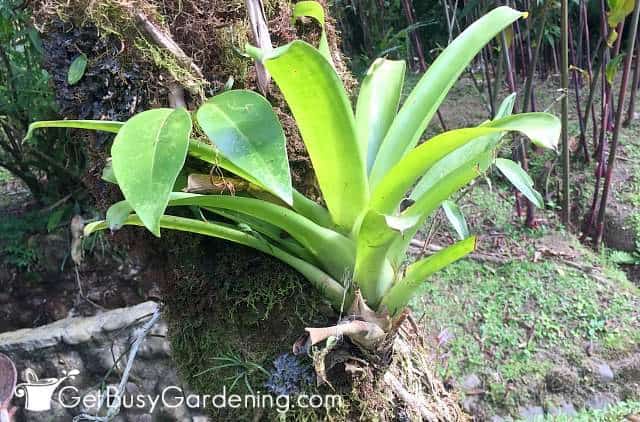
They are slow growing plants, and most of them will only bloom once in their lives because they die after flowering.
Sad I know, but they usually have lots of babies before they die, so you’ll get even more plants out of the deal (but more on that later).
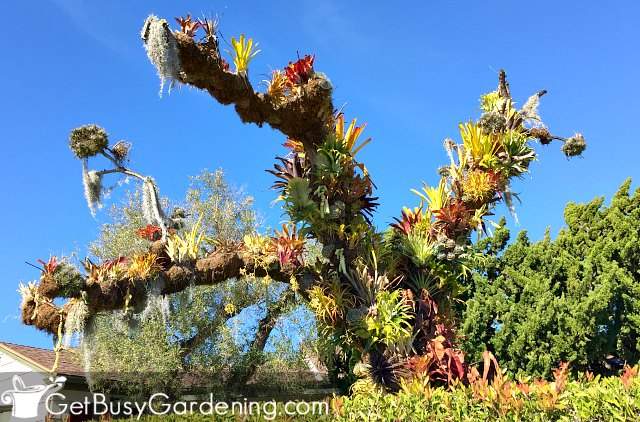
Flowers
Many people think that the large colorful growth that makes bromeliads so popular is the flower, which is a common misconception. That is actually the bract, and not the flower.
The flowers grow out of the colorful bracts. Some are large spikes, and others are tiny and insignificant. Learn all about bromeliad flowers here, including when, how often, and how long they bloom.
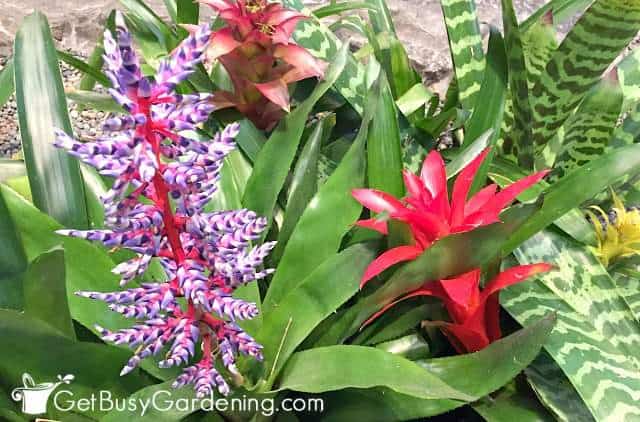
Where To Grow Bromeliads
If you’re lucky enough to live in a tropical climate where it never get below freezing, then you can grow bromeliads outside in your garden.
Otherwise they make wonderful flowering houseplants, and are also pet friendly plants that are safe to grow if you have cats or dogs. Woohoo!
Bromeliad Plant Care Guide
If you’re new to growing these tropical beauties, you’ll find that bromeliad care is much different than any other plant you probably have.
Since they absorb nutrients and water through their leaves, you’ll need to take special care in watering, feeding, and potting them.
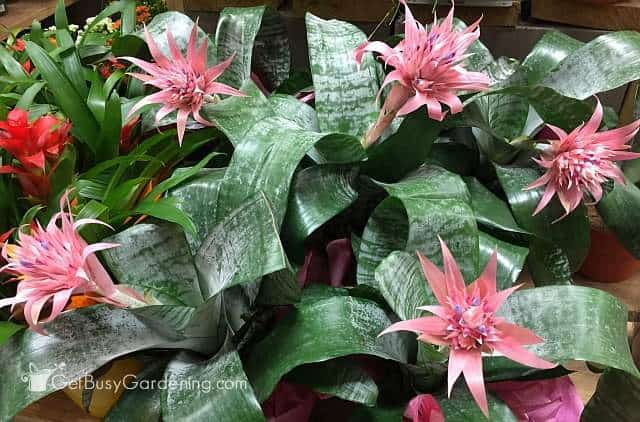
Proper Watering
One thing that’s different about bromeliad plant care is that you don’t water them via the soil. Instead you should keep their center cup filled, and the growing medium on the dry side.
Indoors, dump out the central vase and refresh it every week or so to keep it from going stagnant. Outdoors, you can flush it regularly to keep it clean, if necessary.
Also, be careful about the type you use, because they are very sensitive to the chemicals in regular tap water. Rainwater, distilled, or filtered are the best. Learn more about exactly how to water bromeliads here for the best success.
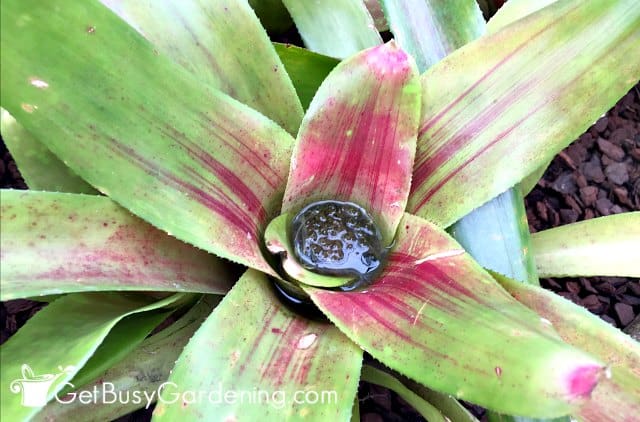
Humidity Requirements
Bromeliads like humid air, so they do best in tropical climates. If you live in an arid region, then you should put misters around them.
Indoors you should mist your plant on a regular basis if your home is dry. Or try putting it in a room that’s naturally more humid, like a bathroom or in the kitchen close to the sink.
You could also run a humidifier during the winter to help keep the humidity level consistent in the room. An indoor humidity monitor is handy to help you give your plant the perfect amount.
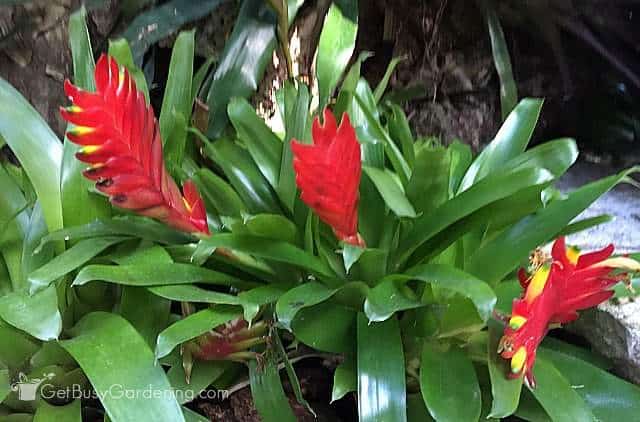
Light
When it comes to sunshine, bromeliads aren’t super fussy, and they make great low light indoor plants. But direct sunlight can burn the leaves, and they’ll grow leggy if it’s too dark.
For best results, put yours in a spot that gets medium to bright, indirect light. A small grow light helps a ton indoors if you don’t have any sunny windows.
Soil
Technically speaking, bromeliads don’t need soil at all. They don’t get their moisture and nutrients from the soil, they use their roots to attach themselves onto trees, plants, or rocks in the wild.
You can mount yours on a log, wood, or a board, or plant it in a container. If you prefer to grow yours in a pot, you can buy a soil mix that’s specifically made for them, or use an orchid medium.
Otherwise, you can make your own soilless medium my mixing sphagnum moss, bark, perlite and/or other coarse organic materials.
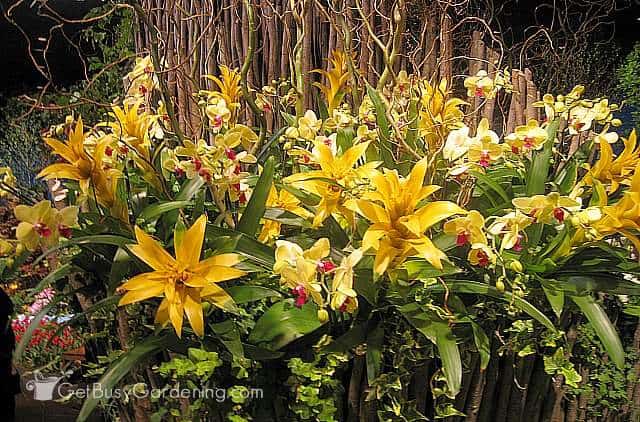
Fertilizer
Bromeliads aren’t heavy feeders, so you don’t need to fertilize the regularly. But, like any plant, they will benefit from the added nutrients – just make sure to feed them sparingly.
Also, it’s important that you always use a natural, organic brand. They are very sensitive to synthetic chemicals, which can easily burn them.
If you’d like to give yours a boost, use a half strength liquid fertilizer or compost tea during the spring and summer months.
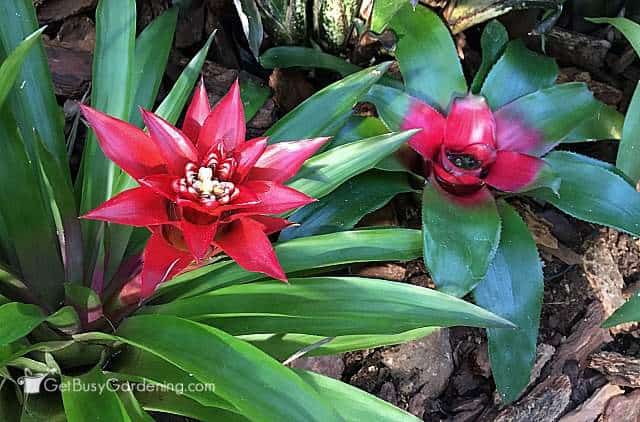
Pest Control Tips
While they don’t usually have much trouble with bugs, sometimes houseplant scale or mealybugs can become a problem. So keep an eye out for these pests during your regular bromeliad care routine.
If you find any, don’t use chemical pesticides. I recommend neem oil, which is a natural insecticide, or an organic insecticidal soap to treat them. Always test any product on a leaf before spraying the whole plant.
Pruning
For the most part, you don’t need to worry about pruning your bromeliad plants. You can trim off dead or dying leaves at any time.
Cut off the flower bract after it dies back, but keep the plant growing as long as you can. Once it dies back completely, you can prune it out.

Tips For Propagating Bromeliad Plants
Like I mentioned above, most bromeliads will eventually fade and die after they’re done flowering. This is a sad fact of life.
But the good news is that they usually have lots of babies before they die. As they come to the end of their life, tiny pups will grow around the base of the main plant.
You can remove these pups once they’re mature enough, or just allow them to grow after the mother plant has died back. Get the full step by step tutorial for how to propagate bromeliads here.
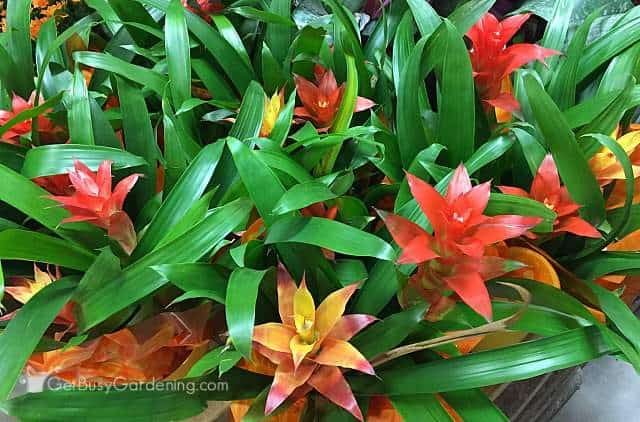
Troubleshooting Common Problems
There’s nothing worse than watching your bromeliad plant die, and you have no idea what’s wrong with it. So in this section, I’ll list some of the most common problems, and give you tips to fix them.
Flower turning brown, or the color is fading
Once the flower bract starts to turn brown or the color fades, it’s a sign that the plant is done blooming and is starting to die, which is a normal part of their life cycle.
Unfortunately, there’s nothing you can do to save the plant once it starts dying. But, don’t toss it out! Keep it growing as long as possible so baby pups have time to form and mature.
Leaves Turning Yellow
When the leaves start turning yellow, it means that your plant may be getting too much or not enough light, or because of improper watering.
Keep it out of the direct sun, and water it by filling the center cup, rather than moistening the soil.
Brown Leaves
The leaves may start to look dry and crispy due to a lack of water or sunburn. They will also start turning brown as the plant naturally dies back after flowering.
Ensure it’s getting the right amount of light and moisture. If it just finished flowering, then prune the brown leaves off as they die back, but keep the green ones growing as long as possible to encourage pups to form.
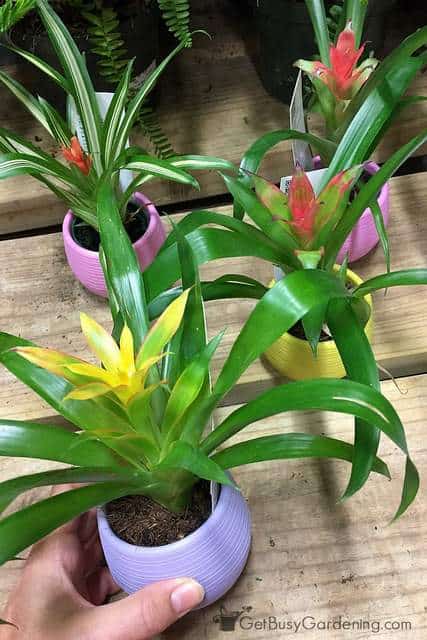
Bromeliads are fun to grow, and it’s not that difficult to care for them. Now that you know all about what they need to thrive, you’ll get the hang of it in no time!
If you want to learn all there is to know about maintaining healthy indoor plants, then you need my Houseplant Care eBook. It will show you everything you need to know about how to keep every plant in your home thriving. Download your copy now!
More Posts About Growing Houseplants
- Rabbit’s Foot Fern Care: How To Grow “Davallia fejeensis”
- How To Care For Rubber Plants
- Complete Tropical Houseplant Care Guide
Do you have any bromeliad plant care tips to add to this list? Please share them in the comments section below.
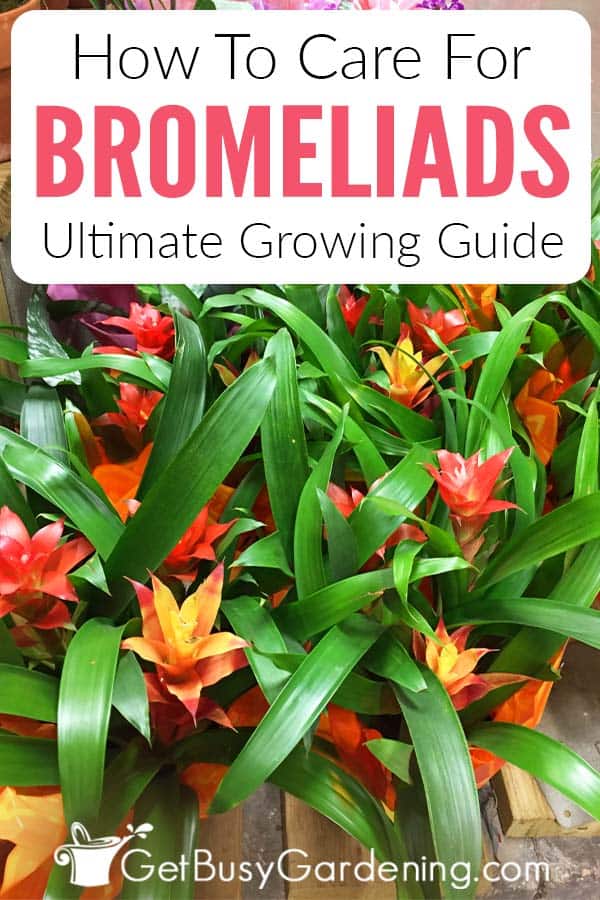
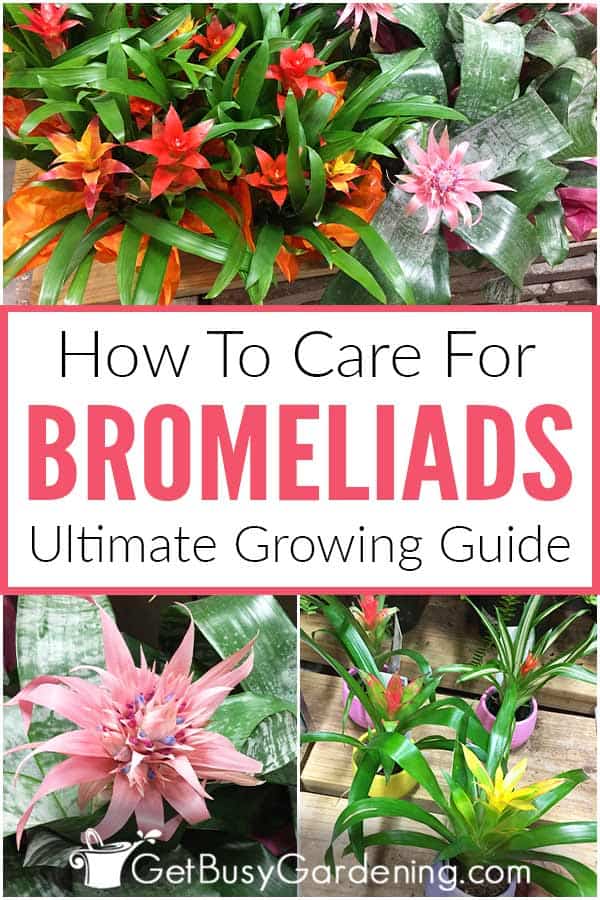


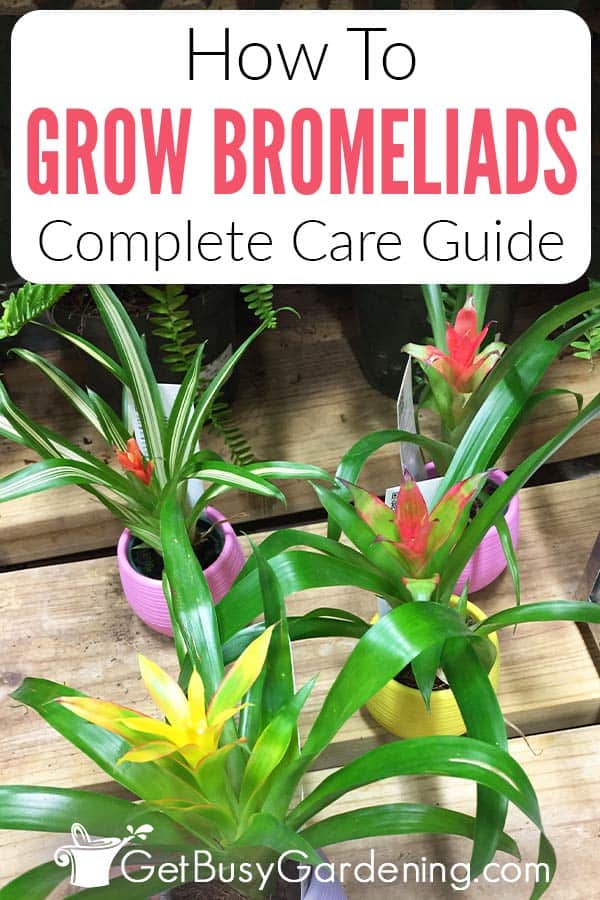
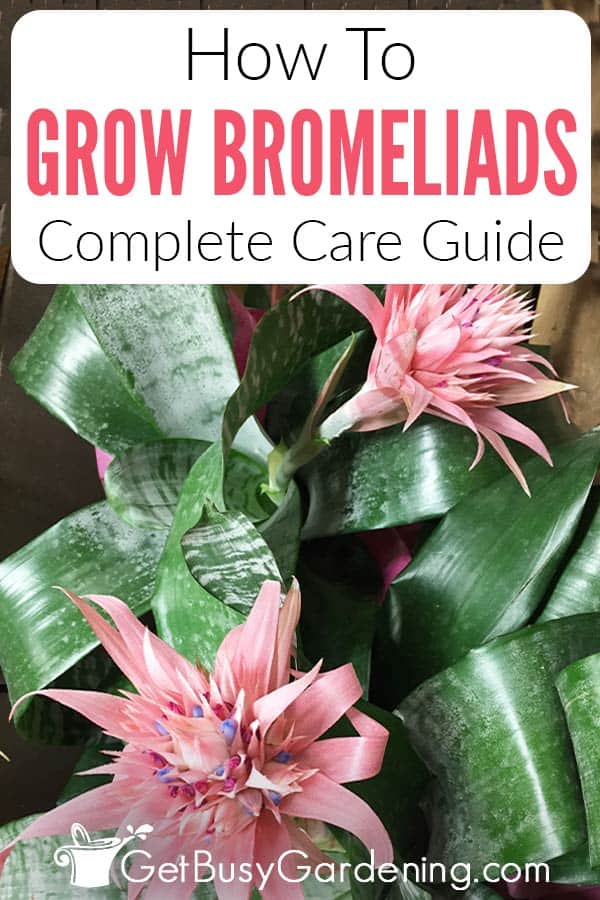
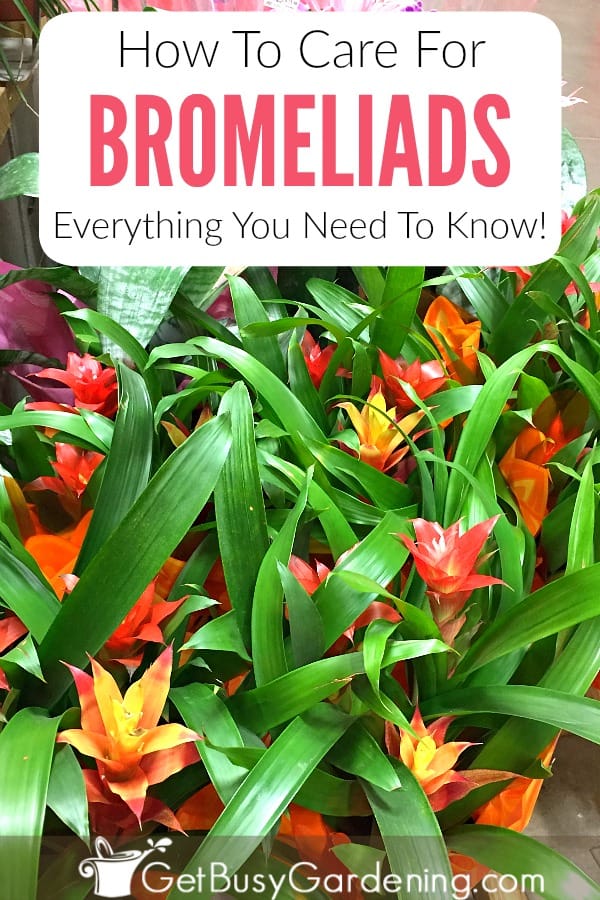



Rachel Moore says
I live in a drought area with water restrictions and we have been encouraged to recycle our shower/bath water for watering plants. i guess from reading the above, that this would kill my bromeliads and that I should rather water with the rain tank water. Just checking as I have my newly planted bromeliads which were gifted to me in amongst plants which are not affected by the recycled water. I would then have to make a special effort with the bromeliads. Your advice and confirmation please. Thanks!
Amy Andrychowicz says
Yes, I would stick to using rainwater for watering your bromeliads.
Fee says
Have gotten so many of these throughout the years (Mother’s Day, ones I couldn’t resist that were so colorful at our local nursery). But I had always thrown them away when they started to brown until I picked up a “dying one” that still had plenty of green foliage from lowe’s For $2. Started researching and didn’t realize they are truly the plant that keeps on giving with its pups! So now I’ve been researching like crazy over the last several months and must say your write-up is one of the best I’ve read! Thanks for the tips and information and for what you are doing for thenplant community. Just subscribed to your YouTube channel and looking forward to seeing you continue to grow!
Amy Andrychowicz says
Oh wow, thanks so much for your nice comment!! I love to hear that you’re hooked on growing bromeliads! So many people toss them out like you said (I used to too!), but they are such wonderful and fun plants that you can keep growing for years!
HANNAH KING says
I am totally confused about this plant .I had no idea they were so much trouble to grow ,I would never have bought it.Thank You for the info.
Amy Andrychowicz says
You’re welcome. Bromeliads really aren’t that tough to grow, you just have to get a hang of their unique care requirements. 🙂
Anne-Mari Bezuidnehout says
I have picked the pink flower of the Brumeliad and would like to know if I can break it in pieces and try to propogate them. Will this work?
Amy Andrychowicz says
No, it will not work. The bromeliad flower cannot be propagated, only by removing the pups around the base of the mother plant.
Audrey says
Hi
I am new to bromeliads and was told that sun until around 11am helps enhance colour. Is this true or are they better off in the shade?
What are the signs of too much sun?
Amy Andrychowicz says
If bromeliads get too much sun, the color will fade and it could also start to burn the leaves. Some varieties can handle more sun that others, so it depends on the type you’re growing.
Gail Casey says
where do I water my bromeliad? what cup are they talking about?
Amy Andrychowicz says
If you go to the section in this post titled “Bromeliad Plant Watering Tips”, there’s a photo at the end of that section that shows you a close up of the center cup. If your bromeliad is flowering, then it may look different. The cup would be at the very bottom of the flower spike.
Janine Andrews says
My plante as new shuts coming out the sides , what do I do with them.?
Amy Andrychowicz says
This is how you propagate bromeliads. Once the mother plant dies, you can remove the side shoots (aka: bromeliad pups or babies), and pot them up in new pots. Or you can just leave the baby bromeliads in the current pot, and prune back the dead mother plant, and they will continue to grow on their own. Then, you can pot them up once they grow a bit larger if you want to wait.
Daniel says
Why the tips turn brown
Amy Andrychowicz says
If the tips are turning brown, it either means your bromeliad isn’t getting enough humidity, or that it has finished flowering and is starting it’s natural process of dying after flowering.
Danny says
Do these plants harm cats?
Amy Andrychowicz says
According to the ASPCA database, bromeliads are safe for cats.
Leonie says
Dear Amy,
I was given 3 beautiful bromeliads in a pot as a present. I harvested and replanted the pups, which are growing slowly. I am in the northern hemisphere. I have one inside with plenty of light; the rest are outside in the shade When can I expect the pups to flower? It is the beginning of October now, but no sign of flowers. I water the cups with distilled water.
Amy Andrychowicz says
Your bromeliad pups have to grow to full maturity before they will bloom. So, depending on the variety you have, it’ll likely take 1-3 years for the pups to reach full maturity.
Ruth says
I live in the Adelaide Hills in South Australia. We have a Mediterranean climate and I have been growing bromeliads outside for the last few years. They are all going gang busters. I’m so pleased as I’ve never been a real green thumb but these plants are doing really well. They are nearly all sending out pups and I’ve been sub dividing some and replanting them. I now have two fern and bromeliad gardens – lush, green and with splashes of colour.
Amy Andrychowicz says
Wow, that sounds amazing!! I’m so happy to hear that your bromeliads are growing so well for you, and they are sending out pups too! Sounds like you have found the perfect spot for them to grow. 🙂
Blema Steinman says
Hi,
I have a bromeliad plant that I love. But recently it has started growing small hairlike blossoms out of the flower. What does that mean and how shall I treat it. Please reply.
thank you
Amy Andrychowicz says
It sounds like the flowers are opening to me. The large colorful spike you see growing on your bromeliad is the floral bract, and not the actual flower. Bromeliad flowers are tiny and they grow out of the floral bracts.
Anne says
I had my bromiliad for a month, maybe more. It’s in daily filtered sunlight. I noticed that the color is not as vibrant. In fact I t is faded. But not the leaves. Only the red flower is very faded. WHat did I do wrong?
I watered the soil. I did not know not to.
Amy Andrychowicz says
You didn’t do anything wrong! It sounds like the flower might be starting to die, which is part of the normal lifecycle of bromeliads. If that’s the case, there’s nothing you can do to save it as the entire plant will eventually die after it flowers. 🙁 Look to see if there are any babies growing out around the base of the plant that you can propagate.
MADGE GULLEY says
AMY, I LIVE IN A CONDO IN ROCKFORD, IL.WE HAVE AN INDOOR POOL, SURROUNDED BY AN ATRIUM THAT IS FILLED WITH TROPICAL PLANTS.I HAVE CREATED A PHOTO GALLERY IDENTIFYING THE PLANT NAMES. I AM READY TO HANG 2 PHOTOS OF 2 DIFFERENT TYPES OF BROMELAIDS.THEY ARE THE TWO TYPES THAT ARE SHOWN AT THE BEGINNING OF YOUR WEBPAGE. I WOULD BE SO VERY GRATEFUL IF YOU COULD E-MAIL THOSE NAMES TO ME…………….MADGE
Amy Andrychowicz says
Wow, that sounds amazing! I’m very jealous of your indoor pool surrounded by an atrium. The bromeliad with the pink flowers is called Aechmea Bromeliad. I’m sorry, but I’m not sure what the other one is called.
Ebony says
How long does it take for them to “flower”? How do I know when they’ve flowered? Mine looks like it is starting to die and the middle section actually completely disconnected itself from the stem… I went to trim some leaves and it came right off.
Amy Andrychowicz says
If the middle section looks dead and has disconnected from the stem, that means your bromeliad is dying. Sorry to be the bearer of bad news! But, look around the base of the mother plant to see if there are any babies growing. If so, then you’ll have lots of new plants! *fingers crossed!!* 🙂
Millicent says
Thank you for the tips..I love these plants, but every one that I have had I have murdered..
I am going to try again.
Amy Andrychowicz says
Oh no! Are you sure they didn’t die because they already flowered? Hopefully next time they will have babies for you before they die. 🙁